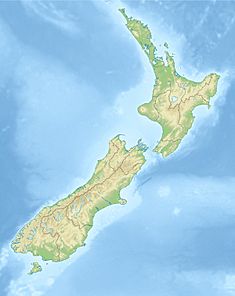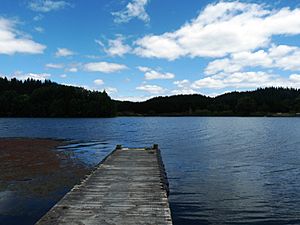Aniwhenua Power Station facts for kids
Quick facts for kids Aniwhenua Power Station |
|
|---|---|
|
Location of Aniwhenua Power Station in New Zealand
|
|
| Country | New Zealand |
| Location | Bay of Plenty |
| Coordinates | 38°18′30.3″S 176°47′27.7″E / 38.308417°S 176.791028°E (For the dam) |
| Purpose | Power |
| Status | Operational |
| Construction began | 1977 |
| Opening date | 1980 |
| Construction cost | NZ$27,767,203 |
| Owner(s) | Southern Generation Partnership |
| Operator(s) | Pioneer Energy |
| Dam and spillways | |
| Impounds | Rangitaiki River |
| Reservoir | |
| Creates | Lake Aniwhenua |
| Surface area | 255 ha |
| Maximum length | 4.5 km |
| Maximum width | Approximately 500 m |
| Maximum water depth | 10 m |
| Power station | |
| Coordinates | 38°17′37.3″S 176°47′32.5″E / 38.293694°S 176.792361°E |
| Operator(s) | Pioneer Energy |
| Commission date | 1980 |
| Type | Run of the river |
| Hydraulic head | 38 metres |
| Turbines | Two |
| Installed capacity | 25 MW (34,000 hp) |
| Annual generation | 127 GWh (460 TJ) |
| Website Aniwhenua Hydro Station |
|
The Aniwhenua Power Station is a special kind of power plant in New Zealand that uses water to make electricity. It's located in the Bay of Plenty region, right on the Rangitaiki River. Imagine a big dam that holds back river water, creating a lake. This water then travels through a long channel and a smaller pond before rushing into the power station. Inside, the moving water spins giant machines that create electricity! After making power, the water flows back into the river. The station gets its name from the beautiful Aniwhenua Falls, which are right next to it.
Contents
Building the Power Station
How Construction Started
Building the Aniwhenua Power Station began in the second half of 1977. First, the builders needed to get permission to use the water and other important approvals. Then, they hired companies to start the construction work and supply the equipment.
What the Builders Did
The main construction work began by the end of 1977. A company called Downer and Company did a lot of the heavy lifting. They dug up a huge amount of dirt, about one million tons! They also used a lot of concrete and steel to build the structures.
When It Started Making Power
The Aniwhenua Power Station started making electricity on October 3, 1980. It cost about NZ$27.7 million to build. By the mid-1980s, the power station was earning enough money to cover its costs and even make a profit.
Who Owned the Power Station
Changes in Ownership
In 1992, a new law in New Zealand changed how electricity companies worked. This law made power boards, which used to be in charge of electricity, become more like regular businesses. Because of this, the Aniwhenua Power Station was transferred to a new company called Bay of Plenty Electricity Limited in 1994. This company was the first electricity company to be listed on the New Zealand stock exchange.
Nova Energy Takes Over
Later, in 1998, another law was passed to encourage more competition in the electricity industry. This meant that companies that distributed electricity (like sending it to homes) had to be separate from companies that generated it (like power stations). So, Bay of Plenty Electricity sold the Aniwhenua Power Station to Nova Energy in 1998. Nova Energy is part of a bigger company called the Todd Corporation.
Repairs and New Owners
While Nova Energy owned the dam, it needed a big repair in 2006. It cost about NZ$2.78 million to fix. In 2015, Nova Energy decided to sell the Aniwhenua Power Station to a group called Southern Generation Partnership. This group is made up of two companies: Pioneer Generation Investments and Roaring Forties. The sale was completed in April 2016. Since December 2018, Pioneer Energy has been in charge of running and maintaining the power station.
How the Power Station Works
The Dam and Lake
The Aniwhenua Power Station uses a dam that is 200 meters long and 10 meters high. This dam holds back the Rangitaiki River and another stream, creating a lake called Lake Aniwhenua. The lake is about 4.5 kilometers long and 500 meters wide, covering an area of 255 hectares. While the deepest part of the lake near the dam is 10 meters, most of it is less than three meters deep. The dam has special gates that can release a lot of water if needed, especially during floods.
Moving the Water
From the dam, the water flows through a concrete-lined channel that is 2.2 kilometers long. This channel carries the water to a smaller pond called the Pahekeheke Headpond. From this pond, two large pipes, called penstocks, carry the water downhill to the power station building.
Generating Electricity
Inside the power station, the rushing water spins two large machines called Francis turbines. These turbines are connected to generators that create electricity. The station produces about 127 GWh of electricity each year. After the water has spun the turbines, it flows back into the Rangitaiki River, just below the Aniwhenua Falls. The water drops about 38 meters from the headpond to the power station, which helps create a lot of power.
Keeping the River Flowing
Even though water is used for power, some water is always released from the dam to keep the original river flowing and to maintain the beautiful Aniwhenua Falls. This released water also powers a small turbine that generates a little extra electricity for the local area.
Sending Power to Homes
The electricity made at Aniwhenua is first sent to local homes and businesses in the Galatea and Kaingaroa regions. If there's extra electricity, it's sent to the Matahina Power Station. From there, the combined power from both stations is sent to the main national electricity grid, which supplies power across New Zealand.
Running the Power Station
How It Operates Daily
The Aniwhenua Power Station is designed to use the natural flow of the river. The lake is not very big compared to the river's flow. This means that during times when less electricity is needed, like overnight, the lake can refill. Then, during the day when more electricity is needed, the water level can be lowered to generate more power. The power station usually generates at least 8 megawatts of power.
Protecting Eels
There's a special program at the power station to help eels. Workers help young eels (called elvers) and adult eels move safely past the dam, both upstream and downstream. This helps to keep the eel populations healthy in the river.
Managing Sediment
Over time, sand and gravel from the river can build up in Lake Aniwhenua. To manage this, the power station has built special banks in the lake to encourage the sediment to settle in deeper areas. They also sometimes lower the lake level and use floods to help clear out the sediment. In 2002, about 30,000 cubic meters of sediment were removed by dredging.



